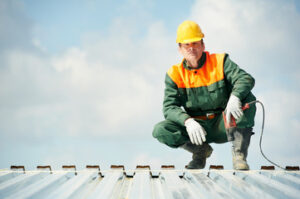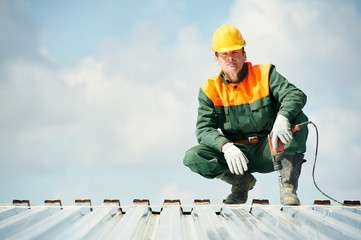Many homeowners make the switch to metal when re-roofing or building a new home. It’s a roofing material that offers several benefits far beyond traditional asphalt options.
Besides their longevity, metal roofs are also environmentally friendly. They’re often made of recycled materials and can be harvested for rainwater for landscape irrigation—a big LEED point earner. For roofing services, contact Round Rock Roofer.
Corrosion is a natural process that all metals undergo. When iron or steel comes into contact with moisture, it reacts to create a flaky, reddish-brown compound we call rust. This reaction weakens the structure of a roof, which is why it’s important to choose a roofing material that can resist corrosion over time.
There are several metals to choose from when it comes to roofs, each offering varying degrees of rust resistance. Some metals, like galvanized steel, require protective coatings to resist rust, while others, such as aluminum, naturally resist corrosion. Some metals can also be pre-rusted to achieve a rustic aesthetic.
The most common causes of corrosion on a metal roof are crevice and filament corrosion. Crevice corrosion occurs when a small volume of stagnant moisture is held next to the surface for a long period of time, allowing the moist air to penetrate the protective coating and corrode the metal underneath. This type of corrosion typically takes place in cracks a few thousandths of an inch wide rather than in wider grooves or slots. Filiform corrosion appears as a thin filament, usually beneath paint but sometimes underneath metal coatings. This type of corrosion doesn’t weaken the metal structurally, but it does negatively affect the appearance of a roof.
Another factor to consider is impact resistance. If you live in an area with frequent hail storms, it’s important to choose a roof that can resist denting. You can look for a metal panel that’s UL 2218 certified to ensure it will not dent easily when exposed to items such as hail.
Longevity
Metal roofs are built to last as long as the house, which is a primary reason homeowners choose them for a re-roofing or new construction project. A metal roof will typically have a lifespan of 40 to 70 years and come with a 50-year warranty.
Metal is a durable roofing material that stands up well to extreme weather conditions, including hail and high winds that cause other roof materials to wear and tear. It also resists fire, a huge plus for those who live in areas prone to wildfires.
Another consideration when choosing a metal roof is the color choice, as not all colors will fade at the same rate. For this reason, it’s important to choose a lighter color to ensure your roof remains attractive for years to come.
Energy Efficiency
When it comes to sustainable living, reducing energy use is one of the most important ways homeowners can reduce their carbon footprint. Thankfully, metal roofs are a great choice for maximizing energy efficiency at home or work. They can reflect up to 70% of the sun’s heat rays, keeping the interior of your building cooler and avoiding the need for increased air conditioning usage.
And unlike traditional shingle roofs, metal roofs don’t make that loud pinging sound when it rains. Rather, the layers of materials between the metal and living space muffle noise so that you’re not disturbed by raindrops while still enjoying the benefits of a durable metal roof.
Additionally, white or light-colored metal roofs reflect more of the sun’s heat rays than dark shingles (67 percent versus 22 percent), which can keep your property cool even after the sun has gone down. This is a major benefit during the summer, when high air conditioning bills can represent up to 70 percent of your energy spending. And because these roofs are recyclable when they reach the end of their life, you can feel good about your roofing choices while lowering your electric bill.
Durability
A metal roof’s lifespan and durability are two of its most important selling points. Properly installed metal roofs can last for 40 to 70 years, often with a manufacturer’s warranty to back them up. They can withstand heavy winds (up to 140 miles per hour), ice, and snow, and are less prone to dents than traditional asphalt shingles.
Because of their durability, homeowners who choose metal roofing may be able to receive a discount on their home insurance. Check with your homeowners’ insurance provider to see if they offer this discount, as well as what types of coverage are covered.
The main downside of a metal roof is that it is extremely slippery when wet or covered with snow, which can be dangerous for anyone trying to walk on it. In addition, snow can “avalanche” off a metal roof in huge quantities, which can damage decks, shrubbery, and cars. People living in areas with heavy snowfalls should consider this a serious consideration when choosing a roof type. In these cases, they may wish to install snow guards to help prevent avalanches.
Aesthetics
A metal roof can be a major component of a building’s overall aesthetic. The type of panel profile and color can make a difference in how the roof looks compared to other homes in the neighborhood. The homeowner’s desired aesthetic should be considered when making a choice.
For example, corrugated metal panels often have exposed fasteners. This is fine for machine shops or cattle barns, but leaves a little to be desired for residential buildings that are known for their curb appeal. A standing seam metal roof provides a more modern architectural aesthetic, utilizing concealed fasteners to create a smooth, sleek appearance.
The beauty of metal roofing is that it can be matched to the building’s wall system to create a cohesive look. Some panel profiles even blend with the wall to make the roof and walls seem like one seamless unit. Contemporary architecture often incorporates this type of roof and wall assembly.
There are a variety of colors to choose from as well. The homeowner may opt for the classic metallic shades, or they can select a more vibrant shade to help their home stand out from other houses in the area. Decorative accents like copper roofs can also be used to add a unique look to the house’s facade.
A metal roofer can also be textured to add depth and dimension to the roof. If the homeowner prefers a more natural look, there are also panels that mimic tiles or cedar shingles. No matter what the homeowner’s preferred aesthetic is, there is a metal roof that can meet and exceed their expectations.

